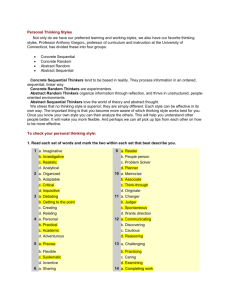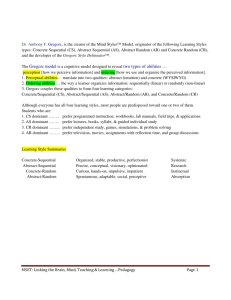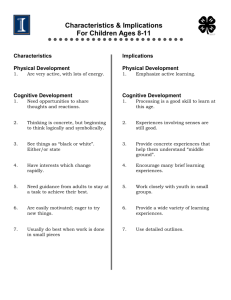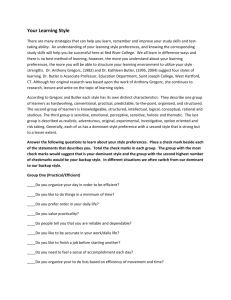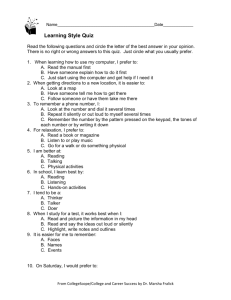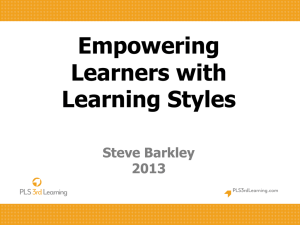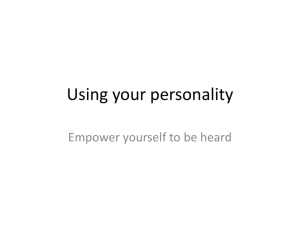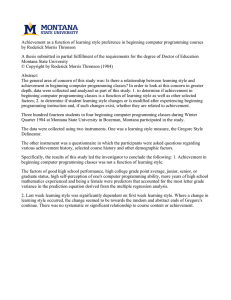Learning Style Questionnaire - Gregorc Model
advertisement
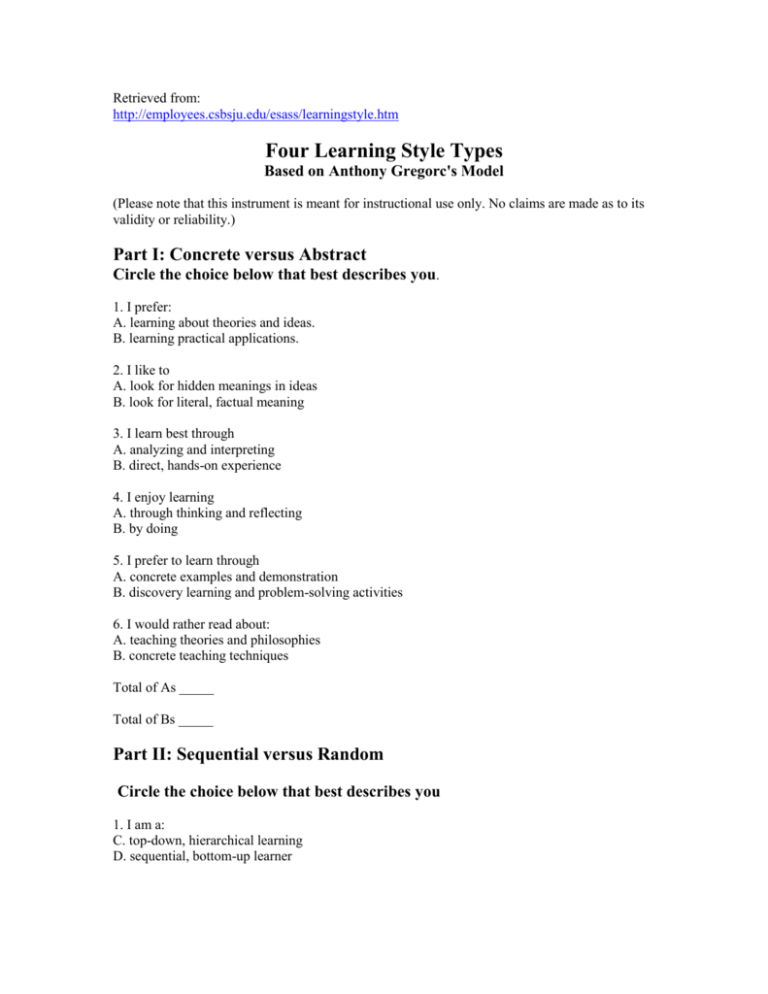
Retrieved from: http://employees.csbsju.edu/esass/learningstyle.htm Four Learning Style Types Based on Anthony Gregorc's Model (Please note that this instrument is meant for instructional use only. No claims are made as to its validity or reliability.) Part I: Concrete versus Abstract Circle the choice below that best describes you. 1. I prefer: A. learning about theories and ideas. B. learning practical applications. 2. I like to A. look for hidden meanings in ideas B. look for literal, factual meaning 3. I learn best through A. analyzing and interpreting B. direct, hands-on experience 4. I enjoy learning A. through thinking and reflecting B. by doing 5. I prefer to learn through A. concrete examples and demonstration B. discovery learning and problem-solving activities 6. I would rather read about: A. teaching theories and philosophies B. concrete teaching techniques Total of As _____ Total of Bs _____ Part II: Sequential versus Random Circle the choice below that best describes you 1. I am a: C. top-down, hierarchical learning D. sequential, bottom-up learner 2. I prefer to learn through: C. making connections between concepts and ideas D. a series of logical, well-defined steps 3. I learn best through a: C. general to specific or non-linear approach D. highly structured, part to whole manner 4. I usually do best on: C. objective tests such as multiple choice or short answer D. essay tests that require answers tying ideas together 5. I learn best in classes where I have to: C. learn the major concepts first and then fit in the details D. learn the individual details first before learning the major concepts 6. I do my best writing when I: C. make a thorough, step-by-step outline and follow it precisely: D. think about the major ideas I want to include and then just start writing Total of Cs _____ Total of Ds _____ Interpretation: A responses = Abstract B responses = Concrete C responses = Holistic (Random) D responses = Sequential Highest totals in B and D = Concrete Sequential Learning Style; B and C = Concrete Random; A and D = Abstract Sequential; A and C = Abstract Random. Anthony Gregorc – Four Learning Style Types: An Overview Many educators recognize two types of learners: holists (global learners) and serialists (sequential or analytical learners). Holists (or random learners as Gregorc class them) are top-down (general to specific) learners who learn best by developing a conceptual framework into which they fit details and specific information. Serialists (or sequential learners), on the other hand, are bottom-up learners who like to lean individual details and then use a series of steps to gain an overall understanding. Gregorc adds another dimension to this concept: learners also have a preference for concrete (literal, actual, hands-on) or abstract (theoretical, conceptual, symbolic), content. This leads to the four learning style combinations or types described below: Concrete Sequential (BD): Prefer direct, hands-on experience, highly organized, sequential lessons, concrete materials, and step-by-step instructions and learning tasks such as workbooks; hands-on, experiential learning; demonstrations; diagrams; computer assisted instruction; and concrete examples/illustrations. This learning style is very compatible with a behavioral teaching style. Concrete Random (BC): Use an experimental, trial and error approach, have “flashes of insight” and make “intuitive leaps” and prefer learning tasks such as learning games, independent study projects, discovery learning/constructivist activities, and problem-solving activities. This learning style is most compatible with a cognitive discovery teaching style. Abstract Sequential (AD): Like written and verbal symbols, often think in “conceptual pictures,” grasp ideas easily through reading and listening, and like learning activities such as reading assignments, lectures about theories and ideas, writing essays, concept maps. This learning style is most compatible with the cognitive expository teaching style. Abstract Random (AC): Prefer to receive information in an unstructured manner, enjoy group discussion, cooperative learning, and multi-sensory experiences, often connect feelings with concepts and ideas and prefer to learn through simulations, discussion-based activities, confluent/holistic education, and cooperative/collaborative learning. This learning style is most compatible with a humanistic teaching style. To order materials related Anthony Gregorc's Style Delineator, go to Gregorc Associates, Inc http://www.gregorc.com References: Gregorc, A. F. An Adult's Guide to Style. Maynard, MA: Gabriel Systems, 1982. Sauve, J. (2004). Styles Comparison. http://chat.carleton.ca/~jsauve/channels.html Seidel, L. E., England, E. M. (1999). Gregorc’s cognitive styles: College students’ preferences for teaching methods and testing techniques. Perceptual and Motor Skills, 83 (3), 859-857.
